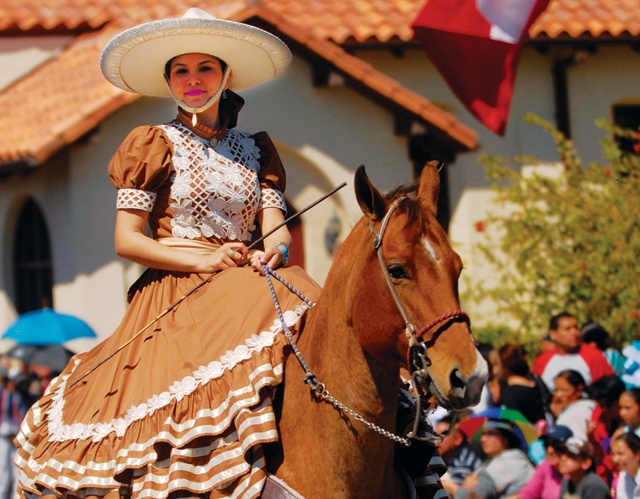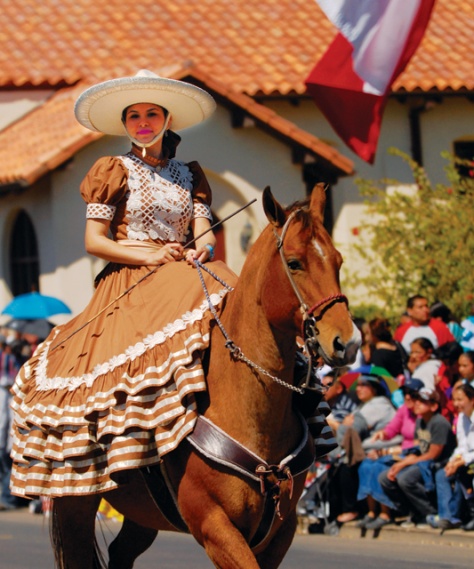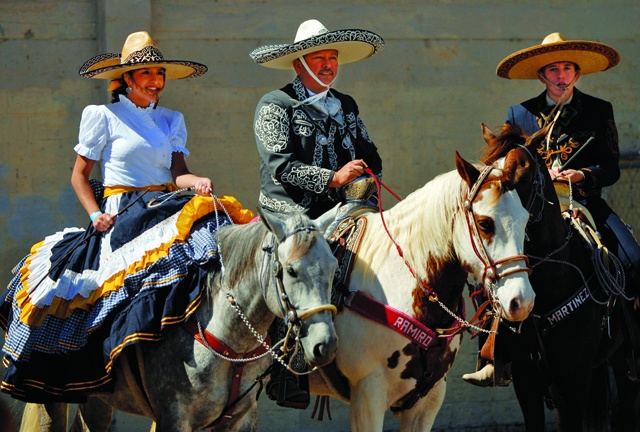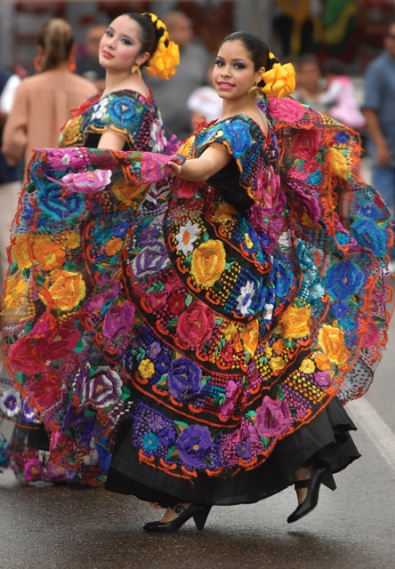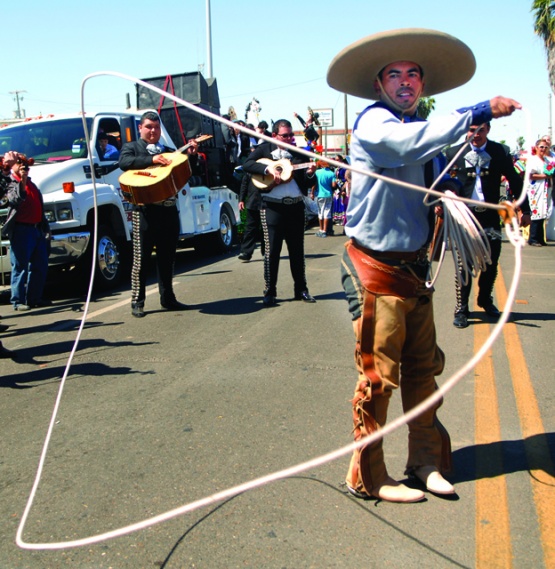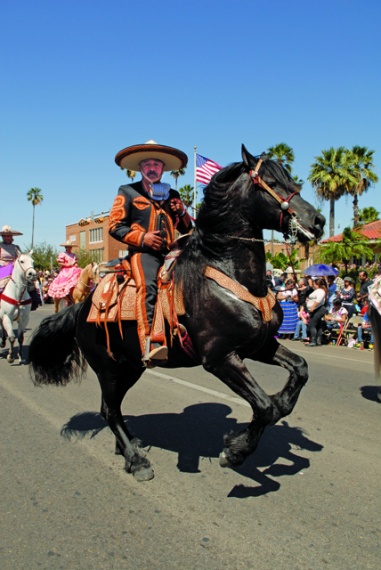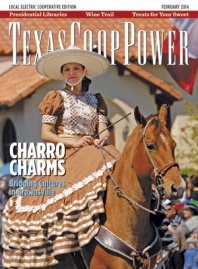With dancing horses, mariachis, four parades and a fiesta spirit, Brownsville celebrates the Charro Days Fiesta each winter in a spectacle of music, dance and colorful costumes. The well-dressed charro—a skilled Mexican horseman—symbolizes the city’s bicultural heritage and its ties to sister city Matamoros across the Rio Grande. A Brownsville tradition since 1938, Charro Days begins with a street dance and continues with nearly nonstop music and parades.
Visiting Brownsville for last year’s Charro Days, I jumped into the opening day of the festival by watching the University of Texas at Brownsville’s folkloric group Tizatlán whirl through the distinctive dances of seven Mexican states against the backdrop of bougainvillea and hacienda arches at Texas Southmost College’s Arts Center. With their hair sleeked back into a froth of ribbons, women in fabulously embroidered skirts mimed stealing kisses from black-suited dance partners. Dazzling dances ranged from the irresistible tempo of the Mexican hat dance, which sets heels stamping and braids flying, to the romance of Veracruz portrayed by dancers in lacy white dresses balancing votive candles on their heads. The Wild West took center stage with suave steps of Sonoran cowboys, thumbs hooked in their belts, circling señoritas.
Sitting next to me, Angelica Garza of Brownsville recalled learning folk dances as a girl years ago, “just for the love of it.”
Highlighting Thursday’s activities each year is the Children’s Parade on Elizabeth Street. With Brownsville schools closed for Charro Days, young customers ringed vendors of ice cream, elotes (Mexican-style grilled corn) and other snacks. Like many watching the parade, middle school teacher Maria Elena Abete donned traditional Mexican attire. Twinkling with sequined starbursts and Aztec designs, her long, flamboyant dress was an Americanized salute to the costumes of Jalisco. “I have about 10 different costumes I wear to school during February,” she told me. “This is the only time of year we get to dress up.”
The roar of laughter announced the approach of Russell Elementary School students performing the traditional Mexican dance known as los viejitos (little old men). The boys, wearing masks and crouched over short canes, wistfully chased girls walking past. Longoria Elementary students in feathered costumes danced past rattling anklets of seedpods, mimicking matachina performers.
Each year, nine Brownsville elementary schools select students to dance their way down the 1.2-mile route. The young dancers are sandwiched between drill teams and middle and high school bands—huge ensembles playing familiar tunes such as the Latin classic “Guantanamera.” The Pace High School flag team marched past wearing long mariachi skirts, followed by a middle school band draped in serapes and a drill team sporting blue sombreros. Teachers escorting the dancers strode past, swishing their long, embroidered skirts, enjoying the parade as much as their students after months of rehearsals. Costumed toddlers on the sidelines marched in time with the passing drums and horns.
Kathy Patience, visiting Brownsville from Iowa for the first time, told me she was impressed by the large marching bands, the huge number of children taking part, the palm trees and the warm February weather. “You’ve got lots more dancing, many more horses and no cow made out of butter,” she said, laughing at the difference between the states’ customs.
“Charro Days is a family tradition. No matter their age, they are experiencing the moment,” said Henry LeVrier, president of Charro Days. “People have participated for generations.”
As a toddler, Jude Benavides rode on his father’s shoulders in the Children’s Parade. Then as a youngster, he rode on floats and later performed in his junior high band. A few years ago, Benavides, now an assistant professor at UTB, showed up to teach a hydrology class I was taking clad in a black charro suit complete with silver conchos, fresh from participating in a fiesta parade.
“Charro Days is about the love and friendship between two nations, and the tremendous history and stories that go with it,” Benavides said. “In the past, just about everyone in Brownsville participated in Charro Days at one point or another. And it’s a good way to mark the end of winter and start of spring.”
While Friday night’s Illuminated Parade draws about 30,000, the crowd doubles for Saturday’s International Parade. High-stepping horses with intricately worked saddles vied for attention with charros dressed in pants and short jackets embellished with silver buttons that sparkled in the tropical sunlight. Riding sidesaddle in long, full skirts, escaramuzas performed complex patterns at full gallop. Charros in white shirts with wide, colorful ties showed off dancing horses, some sporting braided manes. Stepping sideways to music, a riderless horse, cued by long ropes, pranced and threw its mane like a teenage girl smug in her beauty.
The parade evoked cheers and laughter as an adult day care center float bounced down the street as grinning seniors on board danced down memory lane. Sombreros and serapes decorated the grilles of trucks pulling floats filled with mariachi and Tejano musicians. U.S. Border Patrol agents on horseback, trail riders in sharp-creased jeans and plaid shirts, more folk dancers, performers shaking pineapple-shaped maracas and costumed mascots together created a festive mix.
Waving and throwing kisses to the fans of his telenovela, or soap opera, actor Eduardo Yáñez generated rock-star frenzy. The recipient of the title Mr. Amigo for Charro Days 2013, Yáñez certainly met the criteria: a Mexican citizen who fosters binational friendship. Red, white and green banners marked the floats carrying Matamoros officials. Years ago, the International Parade rolled across the Rio Grande and continued into Matamoros. Nowadays, even the traditional meeting of the mayors of Brownsville and Matamoros in the middle of Gateway International Bridge has been scaled back for security reasons. Nevertheless, Charro Days reminds people that the city’s three international bridges unite the two countries, spanning the narrow river that separates them. Without a doubt, this is a binational fiesta.
Meanwhile, in Brownsville’s Washington Park, the three-day Sombrero Festival, held each year during Charro Days, rolled along to the beats of Tejano, country-western and rock music. The family festival, sponsored in part by Magic Valley Electric Cooperative since 2004, includes a jalapeño-eating contest, a tortilla toss, kids’ events, a chili cook-off and a waiters’ race.
Several Magic Valley EC employees volunteer with the Sombrero Festival, including Customer Service Representative Inelda Zuniga, who is the 2014 Sombrero Festival secretary. “The Sombrero Festival is more than just a family-friendly event,” said Zuniga. “We love to give back to the community, just like co-ops. The Sombrero Festival has returned approximately $1.5 million back to the community through nonprofit organizations and direct donations for tourism, beautification and recreation venues in the city of Brownsville.”
Wrapping up last year’s Charro Days, the beloved, high-energy band Mariachi Vargas took the Arts Center stage with their grand sombreros and black costumes accented with silver braid and buttons. Launching into old favorites like “El Rancho Grande,” the concert became a sing-along, and the feeling of community grows strong here with the shared remembrances. The mariachis, considered some of the world’s best, harmonized, clowned a little for the enthusiastic crowd and thrilled the audience with their long, high notes. They proved you don’t have to understand Spanish to become a part of Charro Days.
¡Viva Brownsville!
——————–
Eileen Mattei is a Harlingen writer.
